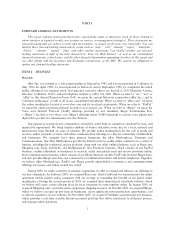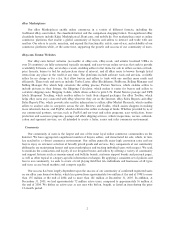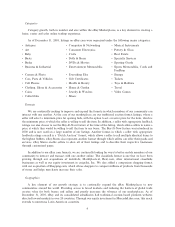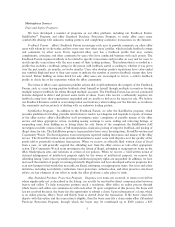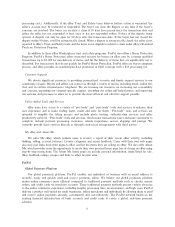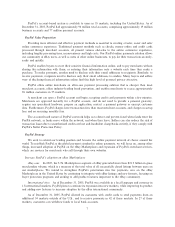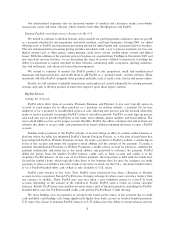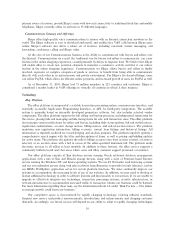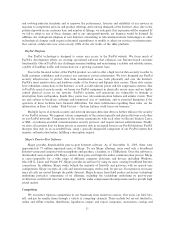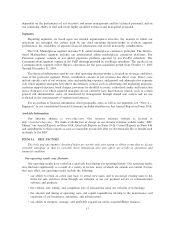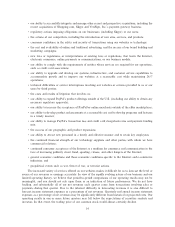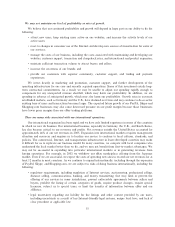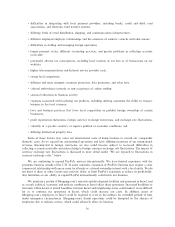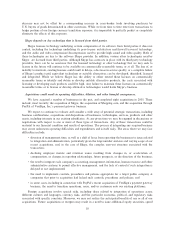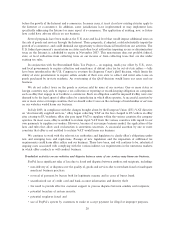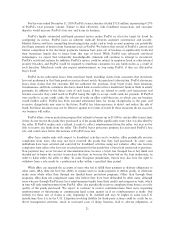eBay 2005 Annual Report Download - page 15
Download and view the complete annual report
Please find page 15 of the 2005 eBay annual report below. You can navigate through the pages in the report by either clicking on the pages listed below, or by using the keyword search tool below to find specific information within the annual report.and evolving industry standards and to improve the performance, features and reliability of our services in
response to competitive services and product offerings and evolving demands of the Internet. Also, due to the
potential growth in our customer base and number of listings, we anticipate that expansion will be required. If
we fail to adapt to any of these changes and to our anticipated growth, our business would be harmed. In
addition, the widespread adoption of new Internet, networking or telecommunications technologies or other
technological changes could require substantial expenditures to modify or adapt our services or infrastructure.
Our current architecture now serves nearly 100% of the site traffic of the eBay platform.
PayPal Platform
Our PayPal technology is designed to assure user access to the PayPal website. We focus much of
PayPal's development efforts on creating specialized software that enhances our Internet-based customer
functionality. One of PayPal's key challenges remains building and maintaining a scalable and reliable system,
capable of handling traffic and transactions for a growing customer base.
Due to the financial nature of the PayPal product, we seek to offer a high level of data security in order to
build customer confidence and to protect our customers' private information. We have designed our PayPal
security infrastructure to protect data from unauthorized access, both physically and over the Internet.
PayPal's most sensitive data and hardware reside at the Denver and Equinix data centers. These data centers
have redundant connections to the Internet, as well as fault-tolerant power and fire suppression systems. Due
to PayPal's special security needs, we house our PayPal equipment in physically secure areas and we tightly
control physical access to our systems. PayPal's systems and operations are vulnerable to damage or
interruption from earthquakes, floods, fires, power loss, telecommunication failures and similar events. They
are also subject to break-ins, sabotage and intentional acts of vandalism, and to potential disruption if the
operators of these facilities have financial difficulties. For more information regarding these risks, see the
information in Item 1A under ""Risk Factors Ì System failures could harm our business.''
Multiple layers of network security and network intrusion detection devices further enhance the security
of our PayPal systems. We segment various components of the system logically and physically from each other
on our PayPal networks. Components of the system communicate with each other via Secure Sockets Layer,
or SSL, an industry-standard communications security protocol, and require mutual authentication. Finally,
we store all customer data we deem private or sensitive only in encrypted form in our PayPal database. PayPal
decrypts data only on an as-needed basis, using a specially designated component of our PayPal system that
requires authentication before fulfilling a decryption request.
Skype's Peer-to-Peer Software
Skype provides downloadable peer-to-peer Internet software. As of December 31, 2005, there were
approximately 75 million registered users of Skype. To use Skype offerings, users need only a broadband
Internet-connected computer with microphone and speakers, a headset, or a USB phone. Once the software is
downloaded, users register with Skype, contact their peers and begin the online communication process. Skype
is cross-compatible for a wide range of different computer platforms and devices including Windows,
Mac OS X, Linux and Pocket PC. Skype provides its software by using its users' existing broadband Internet
connections. In addition, Skype works behind the majority of firewalls and gateways with no special user
configuration. Skype encrypts all calls and instant messages, end-to-end, for privacy. Encryption is necessary
since all calls are routed through the public Internet. Skype licenses from third parties certain key technology
underlying particular components of its offerings, including the technology underlying its peer-to-peer
architecture and firewall traversal technology, and the audio compression/decompression used to provide high
sound quality.
Competition
We encounter vigorous competition in our businesses from numerous sources. Our users can find, buy,
sell, and pay for similar items through a variety of competing channels. These include but are not limited to,
online and offline retailers, distributors, liquidators, import and export companies, auctioneers, catalog and
11


